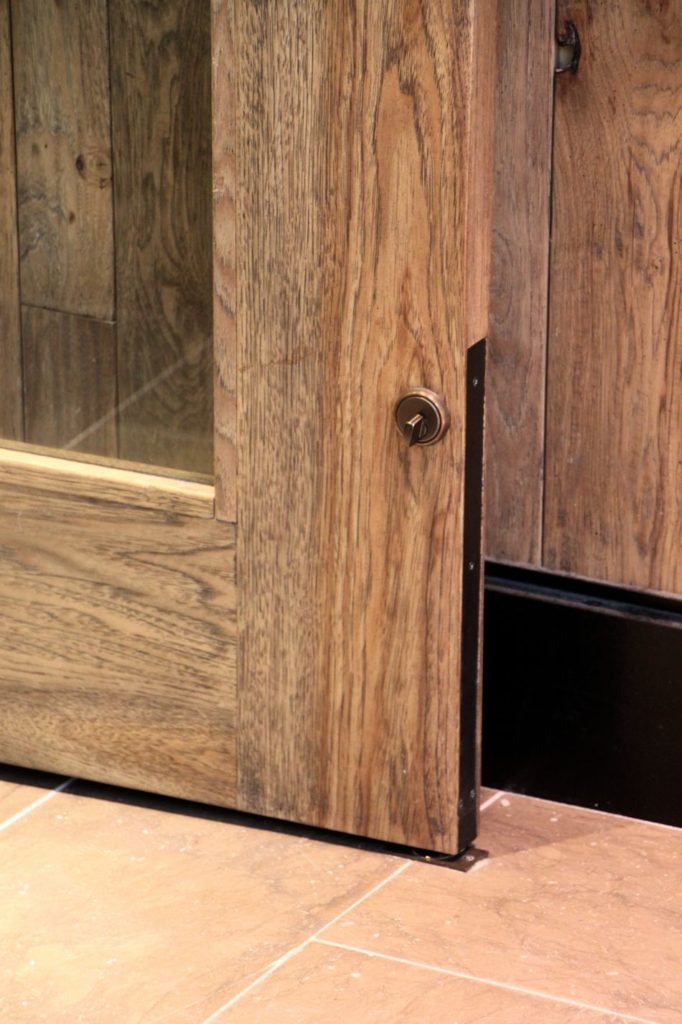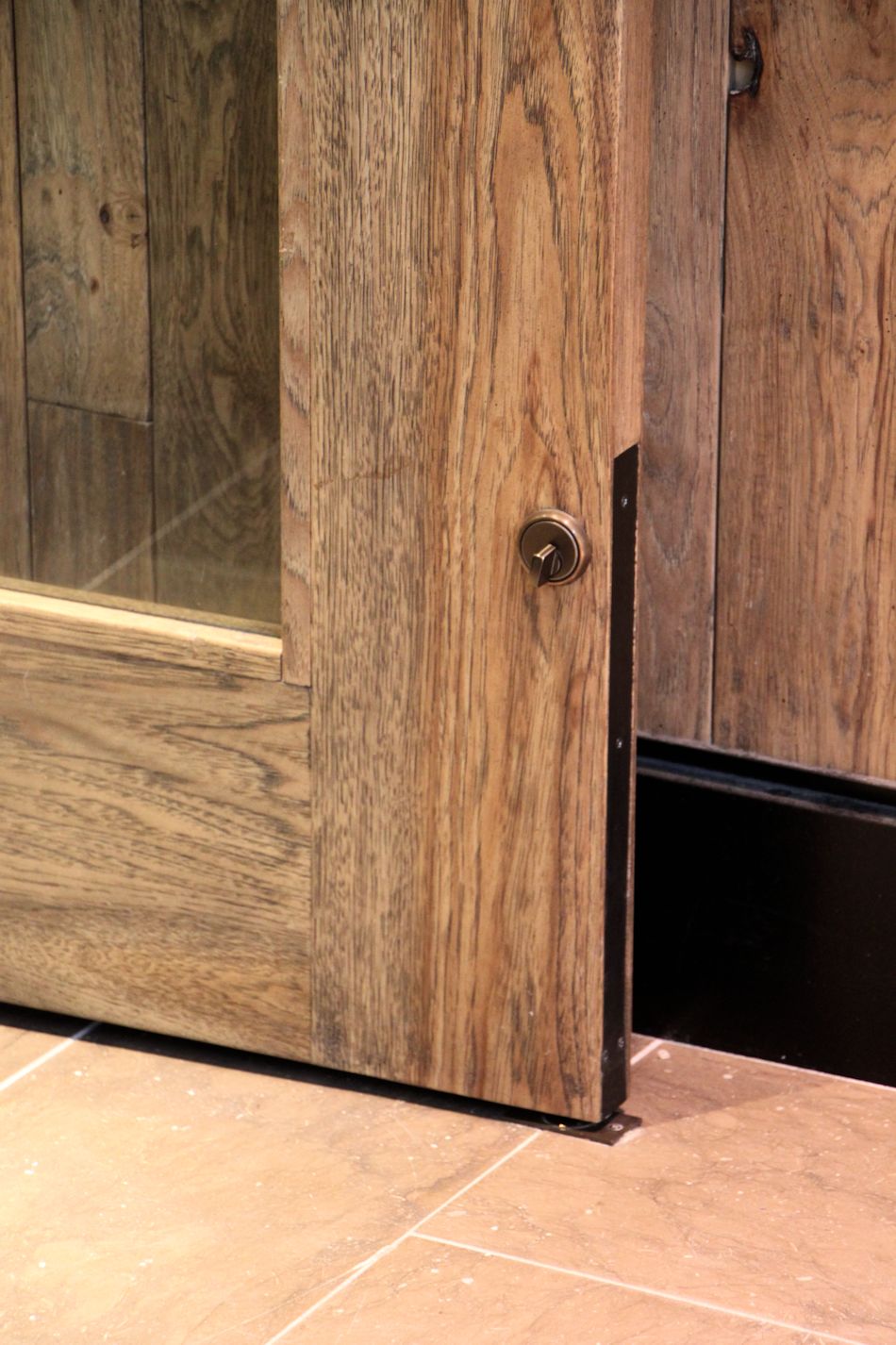This post was published inDoor Security + Safety
.


This thumbturn-operated flush bolt on a retail store could be considered a lock used only for security purposes (IBC), but is it operated only by security personnel (ADA)?
According to the model codes and standards, most operable parts of door hardware, such as lever handles, thumbturns, keypads, and access control readers must be mounted between 34 inches and 48 inches above the floor. This allows the release devices to be operated by the majority of people – adults, children, and people using wheelchairs. State requirements may be more restrictive; for example, the California Building Code requires operable hardware to be mounted between 34 inches and 44 inches above the floor.
Building and Life Safety Codes
In the International Building Code (IBC) and the accessibility standards, there are exceptions to the required mounting height, but the exceptions vary. For example, the IBC states:
Hardware height. Door handles, pulls, latches, locks and other operating devices shall be installed 34 inches (864 mm) minimum and 48 inches (1219 mm) maximum above the finished floor. Locks used only for security purposes and not used for normal operation are permitted at any height.*
According to the IBC Commentary, an example of a lock “used only for security purposes and not used for normal operation” would be a deadbolt mounted in the bottom rail of a glass door serving a retail store. This lock would be unlocked when the store is open, and is not used by customers for access or egress. Keep in mind, however, that a lock mounted in the bottom rail of a door may conflict with the accessibility requirement for a flush, smooth surface with no protrusions in the bottom 10 inches of the door opening height (required on the push side of manually-operated doors).
NFPA 101 – The Life Safety Code requires the releasing mechanism for any latch to be located between 34 inches and 48 inches above the floor, with some exceptions for existing hardware. NFPA 101 does not include an exception to the mounting height for locks used only for security purposes.
Accessibility Standards
The 2010 ADA Standards and the 2017 edition of ICC A117.1 – Accessible and Usable Buildings and Facilities, also exempt some operable hardware on similar grounds.** However, these standards exempt hardware on doors designed to be operated only by security personnel, rather than hardware used only for security purposes. Who would qualify as security personnel? In the ADA standards and the ICC A117.1 Commentary, all of the references to security personnel are related to detention and correctional facilities, courthouses, and guards at security gates. The ADA Guide states:
Manual doors, doorways, and gates that are designed to be operated only by security personnel, such as guards in a jail or prison, are exempt from requirements for hardware, closing speed, and opening force, but must meet all other requirements, including those for maneuvering clearance. This exception applies only where security personnel have sole control of doors or gates. If automated, such doors or gates are required to comply only with provisions for clear width and thresholds, as well as applicable provisions of the referenced ANSI/BHMA Standards.
The ICC A117.1 Commentary clarifies:
Examples of security personnel are guards in jails, bailiffs in courthouses and guards at security gates. The intent is not to exempt all the doors that security personnel use, but to exempt specific features of doors that security personnel are responsible for opening, closing and/or locking for security reasons. Examples would be the door at the cells and between the courtroom and cells in a courthouse. Security personnel should have sole control of the doors. It is not acceptable for security personnel to operate the doors for people with disabilities and allow others independent access.
Classroom Security
Some proponents of installing barricade devices as an alternative security method for classroom doors have theorized that these devices are not required to comply with the accessibility standards because teachers are considered security personnel. Some manufacturers have even claimed that during an active shooter scenario, a classroom becomes “a place of detention and restraint” as referenced in this exception in the IBC: Locks and latches. Locks and latches shall be permitted to prevent operation of doors where any of the following exist: 1. Places of detention or restraint (refer to the IBC for additional exceptions).
A classroom in an educational occupancy can not be deemed “a place of detention and restraint” in order to justify the use of security methods that do not comply with the model codes. Occupancies used for detention have code requirements that provide additional safeguards for people who are not afforded free egress – like fire barriers and opening protectives, sprinkler systems, fire alarms, supervision, and the means to unlock all doors within a prescribed amount of time. A space used as a classroom is required to allow free egress at all times, with one operation to release the latch, and no key, tool, special knowledge, or effort required for egress. The 2018 edition of NFPA 101 specifically requires the releasing mechanisms for classroom door hardware to be mounted between 34 inches and 48 inches above the floor.
The Bottom Line
- The IBC exempts locks used only for security purposes from the mounting height requirements.
- The accessibility standards exempt locks operated by security personnel, which applies to very limited locations. Because this requirement is more stringent than that of the IBC, it’s possible that code officials may not allow the IBC exemption and would instead apply the more limited exemption from the accessibility standards.
- NFPA 101 includes some exceptions for existing hardware, but otherwise requires hardware to be mounted between 34 inches and 48 inches above the floor.
- State requirements may vary from those of the model codes and standards. The more restrictive height requirements in California have resulted in some coordination issues – particularly with access control products.
When in doubt, consult the adopted codes or the Authority Having Jurisdiction for more information.
*Refer to this code section for an additional exemption addressing hardware on pool gates.
**The ADA standards also exempt some existing hardware from the mounting height requirements.
You need to login or register to bookmark/favorite this content.






in California the bottom 34 inches has to be smoothed with no protrusions from the face of the doors
Hi Don –
I looked at the CBC – Section 11B-404.2.10 has the requirement for a flush, smooth surface 10 inches up from the floor. Section 11B-404.2.3 is where it talks about projections in the bottom 34 inches of the door height, and it says: “There shall be no projections into the required clear opening width lower than 34 inches above the finish floor or ground.” This section limits the projections into the REQUIRED clear opening width, which is typically 32 inches. It doesn’t prohibit hardware from projecting off the face of the door, as long as it doesn’t project into the 32-inch clear width. For example, if you have a 4-foot-wide door that provides 45″-46″ of clear width, it could have hardware projecting off of the push-side door face because it would not project into the required 32 inches of clear width. At least that’s how I understand the requirements.
– Lori
Amazing blog post thank you for sharing..
Call me crazy, but if it were up to me, I would only consider the double-cylinder deadbolt to be exempt from the accessibility standards. If a deadbolt were operated by a thumbturn inside, I would want it to be accessible.
My reasoning: In the example of a front door to a retail store, these doors are only locked when the store is closed. The door is unlocked whenever the store is open. And that is an example of where the Code may allow the double-cylinder deadbolt under Section 1010.1.9.4. So the double-cylinder deadbolt at a retail store is a lock that is only used for security purposes (when the store is closed) AND operated only by security personnel (who have the keys).
For a deadbolt operated by thumbturn on the inside, I would want that thumbturn between 34 and 48 inches above the finished floor.
The example of a full glass door with a bottom rail deadbolt: If it were up to me, I might accept the bottom rail deadbolt only in a situation where the Code allowed a double-cylinder deadbolt. If the Code does not allow the double-cylinder deadbolt in that application, I would prefer a locking pull handle that raised the deadbolt thumbturn to 34 to 48 inches above the finished floor.
What about the requirement that locks are required to be readily distinguishable in IBC Section 1010.2.4. Does the lock down low at a typical retail space require it to be readily distinguishable?
Hi Paul –
I think you’re referring to the code section for key-operated locks (double cylinder deadbolts). If so, the lock is required to be readily distinguishable as locked and there isn’t a specific exception for retail space.
– Lori